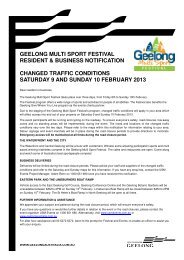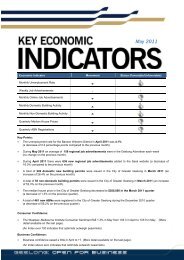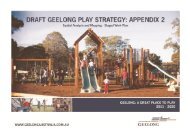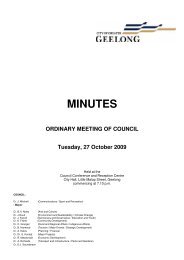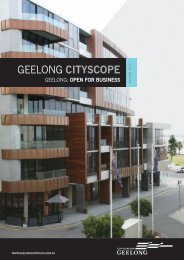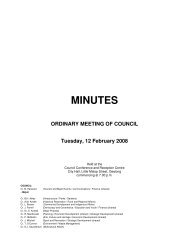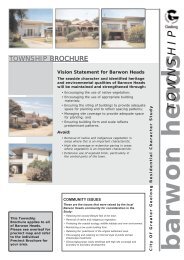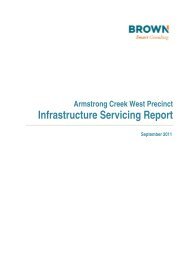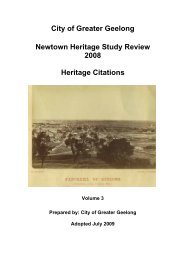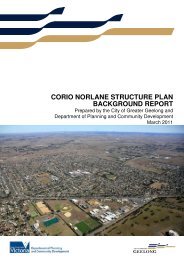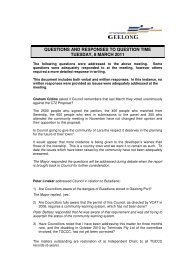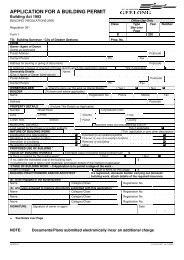armstrong creek urban growth plan volume 1 - City of Greater Geelong
armstrong creek urban growth plan volume 1 - City of Greater Geelong
armstrong creek urban growth plan volume 1 - City of Greater Geelong
Create successful ePaper yourself
Turn your PDF publications into a flip-book with our unique Google optimized e-Paper software.
4.8 MOVEMENT AND ACCESS<br />
This section should be read in conjunction with the Armstrong Creek Urban Growth<br />
Plan Movement and Access Technical Report, February 2006.<br />
4.8.1 VISION<br />
The vision states that:<br />
The potential will be explored for improvements to Marshall Station and for<br />
new, high-quality public transport services to serve the Armstrong Creek<br />
community. Public transport services will be provided from the outset,<br />
<strong>of</strong>fering frequent and reliable services along dedicated corridors to key<br />
destinations including railway stations, central <strong>Geelong</strong>, Deakin University<br />
and Torquay. Development will be organised to ensure that all homes are<br />
within a short walk <strong>of</strong> public transport, reducing reliance on private cars.<br />
Torquay Road, Barwon Heads Road and a future link to the <strong>Geelong</strong> Ring<br />
Road will be developed as <strong>urban</strong> boulevards, continuing to provide good<br />
access into and out <strong>of</strong> the Armstrong Creek area without severing the<br />
communities on either side. Additional main roads will be developed to<br />
provide good vehicle access throughout the <strong>growth</strong> area.<br />
The streets will be designed to provide a comprehensive network <strong>of</strong> safe,<br />
direct and attractive cycle paths and footpaths for commuter and recreational<br />
purposes. This, in combination with the provision <strong>of</strong> daily needs close to all<br />
homes, will enable people to walk or cycle to local destinations such as<br />
neighbourhood shops, public transport, workplaces, primary schools and<br />
parks, supporting healthy lifestyles and avoiding social isolation.<br />
4.8.2 KEY ISSUES<br />
Public Transport<br />
It is likely that private car-based travel will continue to be the dominant mode <strong>of</strong><br />
transport for the foreseeable future, despite increasing fuel prices. However, car<br />
use is a major consumer <strong>of</strong> fossil fuels and a significant source <strong>of</strong> greenhouse<br />
gases. A focus on cars as the primary mode <strong>of</strong> transport also isolates the<br />
substantial proportion <strong>of</strong> the community who cannot drive or do not have ready<br />
access to a car. Further, alternative modes <strong>of</strong> travel such as walking and public<br />
transport promote social interaction which, in turn, fosters a sense <strong>of</strong> community.<br />
ARMSTRONG CREEK URBAN GROWTH PLAN / VOLUME 1 (ADOPTED 13 MAY 2008, AMENDED MAY 2010)<br />
94



